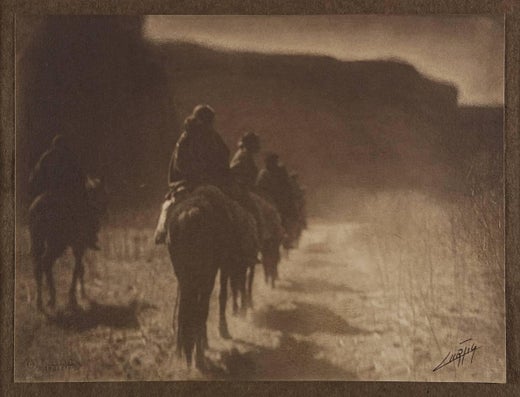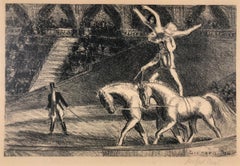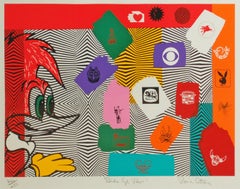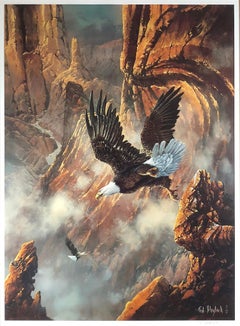Video Loading
Want more images or videos?
Request additional images or videos from the seller
1 of 13
Edward CurtisThe Vanishing Race1904
1904
About the Item
- Creator:Edward Curtis (1868 - 1952, American)
- Creation Year:1904
- Dimensions:Height: 17.75 in (45.09 cm)Width: 19.75 in (50.17 cm)
- Medium:Platinum
- Period:
- Condition:
- Gallery Location:Missouri, MO
- Reference Number:1stDibs: LU747312627622
Edward Curtis
Born in 1868 near Whitewater, Wisconsin, Edward Sheriff Curtis became one of America's finest photographers and ethnologists. Beginning in 1896 and ending in 1930, Curtis photographed and documented every major Native American tribe west of the Mississippi, taking over 40,000 negatives of eighty tribes. For thirty years, he devoted his life to an odyssey of photographing and documenting the lives and traditions of the Native people of North America. His photographs had an immense impact on the national imagination and continue to shape the way we see Native life and culture. His life's work was to record the faces and lifestyles of the Indians before they vanished forever beneath the settling of the continent by the white man. He photographed his subjects from the deserts of the Southwest to the ice floes of the Arctic, recording with his camera and pen the look and the culture of more than eighty tribes. It was an achievement both poignant and monumental.
About the Seller
5.0
Vetted Professional Seller
Every seller passes strict standards for authenticity and reliability
Established in 1970
1stDibs seller since 2017
157 sales on 1stDibs
Typical response time: 1 to 2 days
Authenticity Guarantee
In the unlikely event there’s an issue with an item’s authenticity, contact us within 1 year for a full refund. DetailsMoney-Back Guarantee
If your item is not as described, is damaged in transit, or does not arrive, contact us within 7 days for a full refund. Details24-Hour Cancellation
You have a 24-hour grace period in which to reconsider your purchase, with no questions asked.Vetted Professional Sellers
Our world-class sellers must adhere to strict standards for service and quality, maintaining the integrity of our listings.Price-Match Guarantee
If you find that a seller listed the same item for a lower price elsewhere, we’ll match it.Trusted Global Delivery
Our best-in-class carrier network provides specialized shipping options worldwide, including custom delivery.You May Also Like
Rolex Submariner – Swiss Original Vintage Poster
Located in Zurich, CH
Original Poster promoting Rolex' Submariner, reference 1680, created by Celestino Piatti, a very productive Swiss Graphic Designer (1922-2007) known for his charm and subtle humor, p...
Category
Mid-20th Century Post-Modern Figurative Prints
Materials
Paper
$8,800
Free Shipping
H 50.2 in W 35.63 in D 0.04 in
Luna llena (Full Moon) (1/30)
Located in San Francisco, CA
Rocca Luis César
Luna llena (Full Moon), 2023
Serigraph in five colors
21.70 x 21.70 in
Edition of 30
This serigraph (silkscreen or screen print) is ...
Category
21st Century and Contemporary Modern Animal Prints
Materials
Screen
Birds - XXI century, Figurative print, Black and white, Animals
By Anna Mikke
Located in Warsaw, PL
Limited edition, 8/10. ANNA MIKKE (born in 1950) She graduated from the Academy of Fine Arts in Łódź in 1975. After graduation, she was engaged in graphic design, including designing...
Category
2010s Other Art Style Figurative Prints
Materials
Paper, Etching
$179
H 4.73 in W 10.04 in
Marta F's dog - Contemporary Print, Figurative, Black & white, Polish artist
By Zdzislaw Wiatr
Located in Warsaw, PL
ZDZISŁAW WIATR (born 1960)
He graduated from the Academy of Fine Arts in Cracow, at the Faculty of Graphic Arts in Katowice, where in 1986 he received a diploma with the honourable m...
Category
21st Century and Contemporary Contemporary Figurative Prints
Materials
Paper, Digital
$1,074
H 29.93 in W 22.05 in
Birds - XXI century, Figurative print, Black and white, Animals
By Anna Mikke
Located in Warsaw, PL
Limited edition, 6/10. ANNA MIKKE (born in 1950) She graduated from the Academy of Fine Arts in Łódź in 1975. After graduation, she was engaged in graphic design, including designing...
Category
2010s Other Art Style Figurative Prints
Materials
Paper, Etching
$203
H 9.45 in W 13.39 in
Hermit Crab Cup
By Ken Price
Located in New York, NY
Ken Price
Hermit Crab Cup
1972
Silkscreen on paper
Print: 28 x 22 inches; 71 x 56 cm
Frame: 30 5/8 x 24 3/4 inches; 78 x 63 cm
Edition of 60
Signed, title...
Category
1970s Contemporary Animal Prints
Materials
Screen
Tofcia II and Tofcia III. Contemporary Figurative Etching Print, Animals, Dogs
By Pawel Zablocki
Located in Warsaw, PL
Contemporary figurative etching print by Polish arist living in Canada, Pawel Zablocki. Print depicts dog Tofcia in dynamic poses viewed from the side. Artist's unique technique of p...
Category
2010s Contemporary Figurative Prints
Materials
Paper, Etching
Resting. Contemporary Figurative Etching Print, Female Nude, Polish artist
By Pawel Zablocki
Located in Warsaw, PL
Contemporary figurative etching print by Polish arist living in Canada, Pawel Zablocki. Print depicts a woman laying on her side with head resting on her arm. Artwork is monochromati...
Category
2010s Contemporary Figurative Prints
Materials
Paper, Etching
Belgian sheep dogs II and III. Contemporary Figurative Etching Print, Animals
By Pawel Zablocki
Located in Warsaw, PL
Contemporary figurative etching print by Polish arist living in Canada, Pawel Zablocki. Print depicts three dogs standing in line, each in different pose. Artist's unique technique o...
Category
2010s Contemporary Figurative Prints
Materials
Paper, Etching
Three sketches for new runs. Contemporary Figurative Etching Print, Animals
By Pawel Zablocki
Located in Warsaw, PL
Contemporary figurative etching print by Polish arist living in Canada, Pawel Zablocki. Print depicts three scenes with equestrians. Artist's unique technique of printmaking creates ...
Category
2010s Contemporary Figurative Prints
Materials
Paper, Etching
More From This Seller
View AllBareback Act, Old Hippodrome
By Gifford Beal
Located in Missouri, MO
Bareback Act, Old Hippodrome
By Gifford Beal (1879-1956)
Signed Lower Right
Unframed: 6.5" x 9.5"
Framed: 17.5" x 20"
Gifford Beal, painter, etcher, muralist, and teacher, was born in New York City in 1879. The son of landscape painter William Reynolds Beal, Gifford Beal began studying at William Merritt Chase's Shinnecock School of Art (the first established school of plein air painting in America) at the age of thirteen, when he accompanied his older brother, Reynolds, to summer classes. He remained a pupil of Chase's for ten years also studying with him in New York City at the artist's private studio in the Tenth Street Studio Building. Later at his father's behest, he attended Princeton University from 1896 to 1900 while still continuing his lessons with Chase. Upon graduation from Princeton he took classes at the Art Students' League, studying with impressionist landscape painter Henry Ward Ranger and Boston academic painter Frank Vincent DuMond. He ended up as President of the Art Students League for fourteen years, "a distinction unsurpassed by any other artist."
His student days were spent entirely in this country. "Given the opportunity to visit Paris en route to England in 1908, he chose to avoid it" he stated, "I didn't trust myself with the delightful life in ParisIt all sounded so fascinating and easy and loose." His subjects were predominately American, and it has been said stylistically "his art is completely American." Gifford achieved early recognition in the New York Art World.
He became an associate member of the National Academy of Design in 1908 and was elected to full status of academician in 1914. He was known for garden parties, circuses, landscapes, streets, coasts, flowers and marines. This diversity in subject matter created "no typical or characteristic style to his work."
Beal's style was highly influenced by Chase and Childe Hassam, a long time friend of the Beal family who used to travel "about the countryside with Beal in a car sketching...
Category
20th Century American Modern Animal Prints
Materials
Lithograph
Price Upon Request
Bird's Eye View
By Ronnie Cutrone
Located in Missouri, MO
Ronnie Cutrone (1948-2013)
"Bird's Eye View" c. 1980s
Color Lithograph
Ed. 222/250
Signed, Numbered and Titled
Image Size: 17 x 23.5 inches
Framed Size: approx. 24 x 30 inches.
Ronnie Cutrone, a figurehead of the Pop and Post-Pop art scenes, was Andy Warhol's assistant at the Factory atop the Decker Building from 1972-1980, and worked closely with Roy Lichtenstein, combining stylistic elements of both. Cutrone's large-scale paintings of American cartoon icons, like Mickey Mouse, Felix the Cat, and Woody Woodpecker further reinvented kitsch and popular media in terms of fine art.
Executed in fluorescent monochromatic colors with the finesse of mass-produced silkscreen and prints, Cutrone's works are the reverse of tromp-l'oeil; they use fine art media (watercolor, pastel, crayon - on high-quality paper) to celebrate, rather than hide, the artifice of their subjects. "Everything is cartoon for me", Cutrone is noted for saying, even "ancient manuscripts...
Category
Late 20th Century Pop Art Figurative Prints
Materials
Lithograph
Price Upon Request
Le Christ a l'Horloge, Paris (Christ in the Clock)
By Marc Chagall
Located in Missouri, MO
Marc Chagall
"Le Christ a l'Horloge, Paris" (Christ in the Clock) 1957 (M. 196)
Color Lithograph on Arches Wove Paper
Signed in Pencil "Marc Chagall" Lower Right
Initialed "H.C." (Hors Commerce) Lower Left, aside from numbered edition of 90
*Floated in Gold Frame with Linen Matting, UV Plexiglass
Sheet Size: 18 3/4 x 14 3/4 inches (47.5 cm x 38 cm)
Image Size: 9 3/4 x 8 1/2 inches
Framed Size: 28.5 x 24.25 inches
Marc Chagall was a man of keen intelligence, a shrewd observer of the contemporary scene, with a great sympathy for human suffering. He was born on July 7, 1887 in Vitebsk, Russia; his original name was Moishe Shagal (Segal), but when he became a foremost member of the Ecole de Paris, he adopted French citizenship and the French spelling of his name. Vitebsk was a good-sized Russian town of over 60,000, not a shtetl. His father supported a wife and eight children as a worker in a herring-pickling plant.
Sheltered by the Jewish commandment against graven images, the young Chagall never saw so much as a drawing until, one day, he watched a schoolmate copying a magazine illustration. He was ridiculed for his astonishment, but he began copying and improvising from magazines. Both Chagall's parents reluctantly agreed to let him study with Yehuda Pen, a Jewish artist in Vitebsk. Later, in 1906, they allowed their son to study in St. Petersburg, where he was exposed to Russian Iconography and folk art. At that time, Jews could leave the Pale only for business and employment and were required to carry a permit. Chagall, who was in St. Petersburg without a permit, was imprisoned briefly.
His first wife, Bella Rosenfeld, was a product of a rich cultivated and intellectual group of Jews in Vitebsk. Chagall was made commissar for the arts for the area, charged with directing its cultural life and establishing an art school. Russian folklore, peasant life and landscapes persisted in his work all his life. In 1910 a rich patron, a lawyer named Vinaver, staked him to a crucial trip to Paris, where young artists were revolutionizing art. He also sent him a handsome allowance of 125 francs (in those days about $24) each month. Chagall rejected cubism, fauvism and futurism, but remained in Paris. He found a studio near Montparnasse in a famous twelve-sided wooden structure divided into wedge-shaped rooms. Chaim Soutine, a fellow Russian Jew, and Modigliani lived on the same floor. To Chagall's astonishment, he found himself heralded as one of the fathers of surrealism. In 1923, a delegation of Max Ernst, Paul Eluard and Gala (later Salvador Dali's wife) actually knelt before Chagall, begging him to join their ranks. He refused.
To understand Chagall's work, it is necessary to know that he was born a Hasidic Jew, heir to mysticism and a world of the spirit, steeped in Jewish lore and reared in the Yiddish language. The Hasidim had a special feeling for animals, which they tried not to overburden. In the mysterious world of Kabbala and fantastic ancient legends of Chagall's youth, the imaginary was as important as the real. His extraordinary use of color also grew out of his dream world; he did not use color realistically, but for emotional effect and to serve the needs of his design. Most of his favorite themes, though superficially light and trivial, mask dark and somber thoughts. The circus he views as a mirror of life; the crucifixion as a tragic theme, used as a parallel to the historic Jewish condition, but he is perhaps best known for the rapturous lovers he painted all his life. His love of music is a theme that runs through his paintings.
After a brief period in Berlin, Chagall, Bella and their young daughter, Ida, moved to Paris and in 1937 they assumed French citizenship. When France fell, Chagall accepted an invitation from the Museum of Modern Art to immigrate to the United States. He was arrested and imprisoned in Marseilles for a short time, but was still able to immigrate with his family. The Nazi onslaught caught Chagall in Vichy, France, preoccupied with his work. He was loath to leave; his friend Varian Fry rescued him from a police roundup of Jews in Marseille, and packed him, his family and 3500 lbs. of his art works on board a transatlantic ship. The day before he arrived in New York City, June 23, 1941, the Nazis attacked Russia. The United States provided a wartime haven and a climate of liberty for Chagall. In America he spent the war years designing large backdrops for the Ballet.
Bella died suddenly in the United States of a viral infection in September 1944 while summering in upstate New York. He rushed her to a hospital in the Adirondacks, where, hampered by his fragmentary English, they were turned away with the excuse that the hour was too late. The next day she died.
He waited for three years after the war before returning to France. With him went a slender married English girl, Virginia Haggard MacNeil; Chagall fell in love with her and they had a son, David. After seven years she ran off with an indigent photographer. It was an immense blow to Chagall's ego, but soon after, he met Valentine Brodsky, a Russian divorcee designing millinery in London (he called her Fava). She cared for him during the days of his immense fame and glory. They returned to France, to a home and studio in rustic Vence. Chagall loved the country and every day walked through the orchards, terraces, etc. before he went to work.
Chagall died on March 28, 1985 in the south of France. His heirs negotiated an arrangement with the French state allowing them to pay most of their inheritance taxes in works of art. The heirs owed about $30 million to the French government; roughly $23 million of that amount was deemed payable in artworks. Chagall's daughter, Ida and his widow approved the arrangement.
Written and submitted by Jean Ershler Schatz, artist and researcher from Laguna Woods, California.
Sources:
Hannah Grad Goodman in Homage to Chagall in Hadassah Magazine, June 1985
Jack Kroll in Newsweek, April 8, 1985
Andrea Jolles in National Jewish Monthly Magazine, May 1985
Michael Gibson...
Category
1950s Modern Figurative Prints
Materials
Lithograph
American Eagle (Nest Builder III)
By Ted Blaylock
Located in Missouri, MO
Ted Blaylock (b. 1946)
"Nest Builder III" 1986
Print
Ed. 586/950
Signed and Numbered
Ted Blaylock opened his own art studio and gallery in Collinsville, IL in 1969. He eventually mo...
Category
1980s American Realist Animal Prints
Materials
Paper, Lithograph
Price Upon Request
Les Poissons
By Zao Wou-Ki
Located in Missouri, MO
Zao Wou-Ki (Chinese, French, 1921-2013)
Les Poissons, 1953
Lithograph
Hand-signed in pencil Lower Right
Hand-numbered 16/55 in pencil Lower Left
18 x 23 1/8 inches
29 x 33 inches wit...
Category
1950s Modern Animal Prints
Materials
Lithograph
$12,500
Two Snowy Owls
By Roger Tory Peterson
Located in Missouri, MO
Color Lithograph
Image Size: 30 x 19 inches
Framed Size: 40.25 x 29.75 inches
Edition 392/950
Artist Signed and Numbered
Artist and naturalist Roger Tory Peterson...
Category
Late 20th Century Naturalistic Animal Prints
Materials
Lithograph
Price Upon Request



